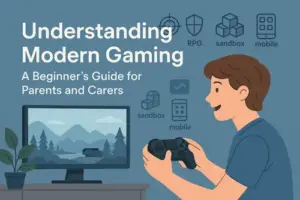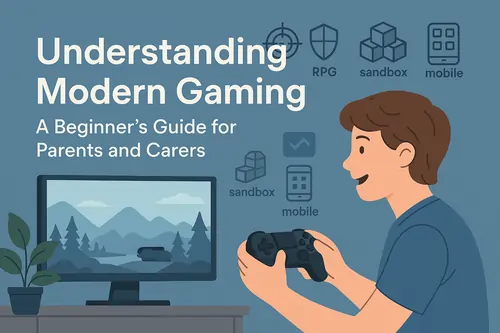What you need to know before saying “Off that game!”
???? Introduction: Gaming Isn’t What It Used to Be
Back in the day, games were simple — a few lives, a joystick, and maybe a bouncing ball. Today? Games are immersive, global, and social. Kids don’t just play games now; they live in them. As a parent or carer, understanding modern gaming helps you support your child, build trust, and set healthy boundaries.
In this guide, we’ll break down the different types of games, explain age ratings, and show you how gaming has evolved into a billion-dollar culture — so you can stop feeling left out of the conversation.

???? Game Types: What Are They Actually Playing?
Understanding game genres can help you talk your child’s language. Here are the most common types you’ll hear about:
???? FPS (First-Person Shooters)
- What it is: You see the game through the character’s eyes and usually control a weapon.
- Examples: Call of Duty, Valorant, Apex Legends
- Why kids love it: Fast-paced, competitive, and team-based.
- Parental Tip: These often contain violence; check the rating and online chat settings.
????️ RPG (Role-Playing Games)
- What it is: You play as a character in a story-rich world, leveling up and making choices.
- Examples: Final Fantasy, Genshin Impact, The Witcher
- Why kids love it: Deep stories, creativity, and immersive worlds.
- Parental Tip: Time-consuming and may include mature themes. Great for older teens.
???? Sandbox/Open-World Games
- What it is: No set path — players explore, create, or survive as they wish.
- Examples: Minecraft, Roblox, Terraria
- Why kids love it: Total freedom to build, explore, or roleplay.
- Parental Tip: These games often include player-created content and online interactions.
???? Mobile Games
- What it is: Casual, quick games usually played on phones or tablets.
- Examples: Clash of Clans, Mobile Legends, Candy Crush
- Why kids love it: Easy to access and play anywhere.
- Parental Tip: Watch out for in-app purchases and ads. Use Google Family Link or Apple Screen Time for limits.
???? Understanding Game Age Ratings
Just like movies, games come with age classifications to guide parents:
- PEGI (Europe), ESRB (USA), and MTRCB (Philippines) are some examples.
- E (Everyone): Great for kids
- T (Teen): Ages 13+
- M (Mature): Ages 17+
- AO (Adults Only): Not recommended for kids at all
???? Pro Tip: Look beyond the rating. Check why the game received that label — violence, suggestive content, gambling features, or online interaction.
???? How Gaming Has Evolved (and Why It Matters to You)
Gaming is no longer a solo hobby. It’s now:
- A social space: Kids make friends, chat, and team up in real-time.
- A digital economy: Players buy skins, passes, and loot boxes.
- A career path: Esports, streaming, game design, and coding are real jobs.
- A form of self-expression: Players choose avatars, build worlds, and share creations.
What used to be a “waste of time” can now build teamwork, critical thinking, resilience, and even income — if guided properly.
????️ What You Can Do as a Parent or Carer
✅ Play with them — or at least sit and watch sometimes
✅ Ask what they love about the game — it builds trust
✅ Use parental controls — from consoles to apps
✅ Schedule screen-free time — balance is key
✅ Stay informed — new games come out every week
???????? Final Thought: You Don’t Have to Be a Gamer — Just Be Curious
You don’t need to understand every power-up or weapon. You just need to show interest, ask questions, and be open to learning. The goal isn’t to control your child’s love for gaming — it’s to guide it with awareness and care.

